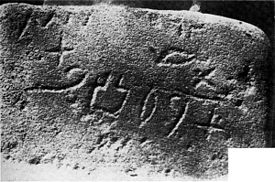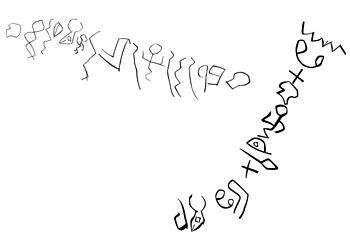- Proto-Sinaitic script
-
History of the alphabet Proto-Sinaitic script? 19 c. BCE
- Ugaritic 15 c. BCE
- Proto-Canaanite 14 c. BCE
- Phoenician 12 c. BCE
- Greek 8 c. BCE
- Aramaic 8 c. BCE
- Kharoṣṭhī 6 c. BCE
- Brāhmī & Indic 6 c. BCE
- Hebrew 3 c. BCE
- Thaana 4 c. BCE
- Pahlavi 3 c. BCE
- Avestan 4 c. CE
- Palmyrene 2 c. BCE
- Syriac 2 c. BCE
- Sogdian 2 c. BCE
- Orkhon (Old Turkic) 6 c. CE
- Old Hungarian c. 650
- Old Uyghur
- Mongolian 1204
- Orkhon (Old Turkic) 6 c. CE
- Nabataean 2 c. BCE
- Arabic 4 c. CE
- Sogdian 2 c. BCE
- Mandaic 2 c. CE
- Paleohispanic 7 c. BCE
- Paleo-Hebrew 10 c. BCE
- Samaritan 6 c. BCE
- Phoenician 12 c. BCE
- Epigraphic South Arabian 9 c. BCE
- Ge’ez 5–6 c. BCE
Hangul 1443Proto-Sinaitic is a Middle Bronze Age script attested in a very small collection of inscriptions at Serabit el-Khadim in the Sinai Peninsula. Due to the extreme scarcity of Proto-Sinaitic signs, very little is known with certainty about the nature of the script. Because the script co-existed with Egyptian hieroglyphs, it is likely that it represented true writing, but this is by no means certain. It has also been argued that Proto-Sinaitic was an alphabet and the ancestor of the Phoenician alphabet, from which nearly all modern alphabets descend.
There have been two major discoveries of inscriptions that may be related to the Proto-Sinaitic script, the first in the winter of 1904–1905 in Sinai by Hilda and Flinders Petrie, dated to the mid 19th century BCE, and more recently in 1999 in Middle Egypt by John and Deborah Darnell, dated to the 18th century BCE.[1]
Contents
Serabit inscriptions
The Sinai inscriptions are best known from carved graffiti and votive texts from a mountain in the Sinai called Serabit el-Khadim and its temple to the Egyptian goddess Hathor (ḥwt-ḥr). The mountain contained turquoise mines which were visited by repeated expeditions over 800 years. Many of the workers and officials were from the Nile Delta, and included large numbers of "Asiatics", speakers of the Canaanite language that was ancestral to Phoenician and Hebrew, who had been allowed to settle the eastern Delta.[1]
Most of the thirty or so inscriptions have been found among much more numerous hieratic and hieroglyphic inscriptions, scratched on rocks near and in the turquoise mines and along the roads leading to the temple. Four inscriptions have been found in the temple, on two small human statues and on either side of a small stone sphinx. They are crudely done, suggesting that the workers who made them were illiterate apart from this script. In 1916, Alan Gardiner, using sound values derived from the alphabet hypothesis, translated a collection of signs as לבעלת l bʿlt (to the Lady)[2] One of the instances of this collection of signs was on the small stone sphinx, which contained a bilingual inscription: The Egyptian reads The beloved of Hathor, the mistress of turquoise, and according to Gardiner's translation, the Proto-Sinaitic reads m’hb‘l (the beloved of the Lady; m’hb beloved), with the final t of bʿlt (Lady) not surviving. Egyptologist Orly Goldwasser believes the script was most likely invented during the reign of pharaoh Amenemhet III of the Twelfth Dynasty.[1]
The script has graphic similarities with the Egyptian hieratic script, the less elaborate form of the hieroglyphs. In the 1950s and 60s it was common to show the derivation of the Canaanite alphabet from hieratic, using William Albright's interpretations of Proto-Sinaitic as the key. It was generally accepted that the language of the inscriptions was Semitic and that the script had a hieratic prototype. If correctly translated, the word baʿlat (Lady) lends credence to the identification of the language as Semitic. However, the lack of further progress in decipherment casts doubt over the other suppositions, and the identification of the hieratic prototypes remains speculative.[citation needed]
Alphabet hypothesis
Proto-Sinaitic is hypothesized to be an intermediate step between Egyptian hieroglyphs and the Phoenician alphabet. If this is the case, Proto-Sinaitic may be the first alphabet. According to the alphabet theory, the alphabet began with Proto-Sinaitic at the end of the Middle Bronze Age and split into the South Arabian script and the Proto-Canaanite script in the Late Bronze Age. The Proto-Canaanite script would then have evolved into Phoenician proper by 1100 BCE.[3] The theory centers around the idea that only the graphic form of the Proto-Sinaitic characters derive from Egyptian hieroglyphs, and that they were given the sound value of the first consonant of the Semitic translation of the hieroglyph. (Using a character for the first sound of its name is the acrophonic principle.) For example, the hieroglyph for pr "house" (a rectangle partially open along one side, "O1" in Gardiner's sign list) was adopted to write Semitic /b/, after the first consonant of baytu, the Semitic word for "house".[1] According to the alphabet hypothesis, the shapes of the letters would have evolved from Proto-Sinaitic forms into Phoenician forms, but the names of the letters would have remained the same. Below is a table showing selected Proto-Sinaitic signs and the proposed correspondences with Phoenician letters. Also shown are the sound values, names, and descendants of the Phoenician letters.
Possible correspondences between Proto-Sinaitic and Phoenician Proto-Sinaitic Phoenician Phoen. value Phoen. name Hebrew Greek Latin Arabic 

ʼ ʾalp "ox" א Α A ا 

b bet "house" ב Β B ب 

k kap "hand" כ Κ K ك 

m mem "water" מ Μ M م 

ʻ ʿen "eye" ע Ο O ع 

r roʾš "head" ר Ρ R ر Proto-Canaanite inscriptions
Only a few inscriptions have been found in Canaan itself, dated from ca. the 17th century BCE. They are all very short, most consisting of only a couple of letters, and may have been written by Canaanite caravaners or soldiers from Egypt.[1] They sometimes go by the name Proto-Canaanite,[4] although the term "Proto-Canaanite" is also applied to early Phoenician or Hebrew inscriptions.[5]
Wadi el-Hol inscriptions
The Wadi el-Hol inscriptions (Arabic وادي الهول Wādī al-Hūl 'Ravine of Terror') were carved on the stone sides of an ancient high-desert military and trade road linking Thebes and Abydos, in the heart of literate Egypt. They are in a wadi in the Qena bend of the Nile, at approx. 25°57′N 32°25′E / 25.95°N 32.417°E, among dozens of hieratic and hieroglyphic inscriptions. The inscriptions are graphically very similar to the Serabit inscriptions, but show a greater hieroglyphic influence, such as a glyph for a man that was apparently not read alphabetically.[1]
H1 is a figure of celebration [Gardiner A28], whereas h2 is either that of a child [Gardiner A17] or of dancing [Gardiner A32]. If the latter, h1 and h2 may be graphic variants (such as two hieroglyphs both used to write the Canaanite word hillul "jubilation") rather than different consonants.
Hieroglyphs representing celebration, a child, and dancing respectively. The first appears to be the prototype for h1, while the latter two have been suggested as the prototype for h2.Some scholars (Darnell et al) think that the רב rb at the beginning of Inscription 1 is likely rebbe (chief; cognate with rabbi); and that the אל ’l at the end of Inscription 2 is likely ’el "(a) god". Brian Colless has published a translation of the text, in which some of the signs are treated as logograms (representing a whole word, not just a single consonant) or rebuses [Antiguo Oriente 8 (2010) 91] [V] “Excellent (R[’š]) banquet (mšt) of the celebration (H[illul]) of `Anat (`nt). ’El (’l) will provide (ygš) [H] plenty (rb) of wine (wn) and victuals (mn) for the celebration (H[illul]). We will sacrifice (ngt_) to her (h) an ox (’) and (p) a prime (R[’sh]) fatling (mX).” This interpretation fits into the pattern in some of the surrounding Egyptian inscriptions, with celebrations for the goddess Hathor involving inebriation.
See also
- Abjad
- Byblos syllabary
- Ugaritic script
References
- ^ a b c d e f Goldwasser, Orly (Mar/Apr 2010). "How the Alphabet Was Born from Hieroglyphs". Biblical Archaeology Review (Washington, DC: Biblical Archaeology Society) 36 (1). ISSN 0098-9444. http://www.bib-arch.org/bar/article.asp?PubID=BSBA&Volume=36&Issue=02&ArticleID=06. Retrieved 06-Nov-2011.
- ^ baʿlat (Lady) is a title of Hathor and the feminine of the title Baʿal (Lord) given to the Semitic god.
- ^ John F. Healey, The early alphabet University of California Press, 1990, ISBN 978-0-520-07309-8, p. 18.
- ^ Roger D. Woodard, 2008, The Origins of the West Semitic Alphabet in Egyptian Scripts
- ^ "Earliest Known Hebrew Text In Proto-Canaanite Script Discovered In Area Where 'David Slew Goliath'". November 3, 2008. http://www.sciencedaily.com/releases/2008/11/081103091035.htm.]
Literature
- Albright, Wm. F. (1966) The Proto-Sinaitic Inscriptions and their Decipherment
- Colless, Brian E., "The proto-alphabetic inscriptions of Sinai", Abr-Nahrain 28 (1990) 1-52.
- Colless, Brian E., "The proto-alphabetic inscriptions of Canaan", Abr-Nahrain 29 (1991) 18-66.
- Colless, Brian E., “The Byblos Syllabary and the Proto-alphabet”, Abr-Nahrain 30 (1992) 15-62.
- Colless, Brian E., “Proto-alphabetic Inscriptions from the Wadi Arabah”, Antiguo Oriente 8 (2010) 75-96.
- Stefan Jakob Wimmer / Samaher Wimmer-Dweikat: The Alphabet from Wadi el-Hôl – A First Try, in: Göttinger Miszellen. Beiträge zur ägyptologischen Diskussion, Heft 180, Göttingen 2001, p. 107-111
- J. Darnell and C. Dobbs-Allsopp, et al., Two Early Alphabetic Inscriptions from the Wadi el-Hol: New Evidence for the Origin of the Alphabet from the Western Desert of Egypt, Annual of the American Schools of Oriental Research 2005.
- Hamilton, Gordon J, The origins of the West Semitic alphabet in Egyptian scripts (2006)
- Fellman, Bruce (2000) "The Birthplace of the ABCs." Yale Alumni Magazine, December 2000.[1]
- Sacks, David (2004). Letter Perfect: The Marvelous History of Our Alphabet from A to Z. Broadway Books. ISBN 0-7679-1173-3.
- Millard, A. R. (1986) "The Infancy of the Alphabet" World Archaeology. pp. 390–398.
- Ray, John D. (1986) "The Emergence of Writing in Egypt" Early Writing Systems; 17/3 pp. 307–316.
External links
- USC West Semitic Research Project site on Wadi el-Hol, with photos
- Photos of Proto-Sinaitic and later Semitic inscriptions
- Proto-Sinaitic TrueType font for your computer
- Ancient Hebrew Alphabet – chart for comparison
- Comprehensive study of Proto-Sinaitic corpus (in Spanish)
- The Tower of Babel – an academically-affiliated etymology database
- How the Alphabet Was Born from Hieroglyphs Biblical Archaeology Review, Mar/Apr 2010
News articles
Categories:- Abjad writing systems
- Bronze Age writing systems
- Scripts without ISO 15924 code
- Undeciphered writing systems
Wikimedia Foundation. 2010.





